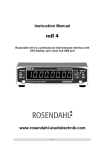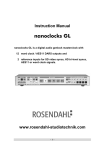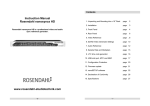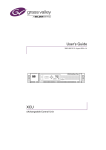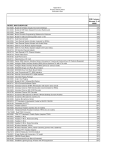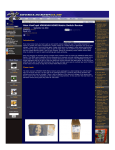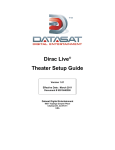Download Rosendahl mif 4 Instruction manual
Transcript
Instruction Manual mif 4 Rosendahl mif 4 is a professional midi timecode interface with LED display, sync input and USB port www.rosendahl-studiotechnik.com -1- -2- Contents 1. Unpacking and mounting into a 19" rack 2. Powering up and selecting timecode SOURCE 3. LTC input mode 4. MTC and USB input modes 5. GEN generator mode 6. DISPLAY modes 7. Setup utility 8. USB drivers 9. Declaration of conformity 10. Specifications page page page page page page page page page page 3 4 5 6 7 9 11 12 13 14 1. Unpacking and mounting into a 19" rack mif 4 comes with the following accessories: 1 pcs power adapter with country-specific clip 1 pcs USB cable 2 pcs 1U rackmount brackets 1 pcs user manual that you are now reading The unit is shipped with four small plastic feet mounted underside with Philips screws. If you want to rackmount your mif 4, please detach the four plastic feet first and keep the M3x6mm Philips screws. Now remove the black countersunk screws on the left and right side of the unit to assemble the rack mount brackets using the M3x6mm Philips screws. -3- 2. Powering up and selecting timecode SOURCE Connect the USB port to a host computer or use the external power adapter to supply your mif 4. Each time the unit is powering up the installed firmware version is shown in the display for two seconds. This manual relates to firmware version 2.1 from Oktober 2012. The left key is used to select the timecode SOURCE. Short keypresses will navigate through the four input modes: LTC: longitudinal timecode (SMPTE 12M) from the LTC IN MTC: midi timecode from the MIDI IN. USB: midi timecode from a host computer connected via USB. GEN: manually or MMC controlled timecode generator mode. Holding down the left key for two seconds causes (1) a JAM SYNC from applied, running timecode into the GEN mode (2) or if no timecode signal is present, you will be able to store the default SOURCE setting to non volatile memory. (See generator section for more informations about JAM SYNC) -4- 3. LTC input mode LTC is longitudinal timecode according SMPTE 12M, there are 80 bits containing time, userdata and a syncword. The unit detects the incoming LTC frame format automatically. The FPS LEDs 24, 25, 30 and DF indicate the detected format. 24 FPS timecode is used for movie productions. 25 FPS timecode is the standard European video frame rate but is also common for European audio productions. 30 FPS timecode is used for audio and high definition video productions in Japan and the US. 30 FPS pull down resulting in 29.97 FPS is used for NTSC or high definition video productions (pull down). 30 and DF indicates the drop frame format used only for pull down video applications where correlation to time of day is mandatory. These LEDs are all unlighted if no input signal is applied, so they also serve to indicate ISP (Input Signal Present) status. Continious timecode, running forward, within +/- 6% of nominal speed will be translated into MTC timecode and sent to the MIDI and USB output ports. Simultaneously stable, regenerated LTC is fed to the LTC output. I.e. 29.97 FPS non drop timecode is 30 FPS timecode running 0.1% slower (defined as 1000/1001 pull down rate) and within the 6% window. The timecode speed is displayed in the DISPLAY mode CAL. 1.0000 indicates timecode running at nominal speed. 29.97 FPS non drop timecode will be displayed as 30 FPS running at 0.9990. 29.97 DF drop frame timecode is indicated by LED 30 and LED DF with a calibration factor CAL 0.9990 23.98 FPS is indicated by LED 24 and a calibration factor 0.9990. -5- Timecode faster or slower than 6% or timecode running reverse is translated into so-called MTC full messages. MTC full messages are used to spot a DAW or other MTC controlled software to a specific location, just like a locater. In operation mode SOURCE = LTC a video sync input signal does not influence the LTC to MTC translation process. Synchronisation is always referenced to the LTC Input signal, indicated in CAL DISPLAY mode by "I" ( I 1.0000 ). The default timecode standard after powering up is defined by the non volatile stored settings made in the generator setup (section 5). Detection of a different timecode standard takes one time 2-3 seconds. A correctly setup default standard avoids this delay each time after powering up. 4. MTC and USB input modes Digital Audio Workstations as well as lighting and show control software use MTC midi timecode for synchronisation. mif 4 reads MTC to regenerate synchronised, stable LTC and MTC timecode. MTC timecode can be quite unstable and jittery caused by the latency of computer operating systems. For this reason, mif 4 makes use of slow and integrating sync algorithms. If the unit receives an MTC full message, it will stop and generate a short burst of stationary LTC timecode. The unit repeats one LTC frame 8 times. On the LED display there are DECIMAL POINTS to separate hours, minutes, seconds and frames (00.00.00.00.). The rightmost decimal point (to the right of the frame digits) is used as a LOCKED indicator. -6- If the unit is in sync and outputs locked timecode, this LOCKED indicator will light up. In MTC or USB input modes the LOCKED threshold is < 5ms, in LTC mode < 100µS. If the incoming midi timecode is jumping or drifting away so that mif 4 is unable to follow the source, it will display ERROR 01 in MTC mode or ERROR 02 in USB mode. In this case a stop and restart of the timecode synchronisation will be executed. 5. GEN generator mode To edit and start the timecode generator manually please select the generator mode (SOURCE = GEN) and display mode timecode (DISPLAY = TC). Now press and hold the left key for about two seconds until the HOUR digits and the right key start blinking. Change the "HOUR" setting with the right key. Holding down this key for a second will automatically count up the "HOUR" value. Press the left key again to navigate to MINUTES. Change the "MINUTES" value using the right key. Press the left key again to navigate to FPS section. (FPS = Frame Per Second) Select the timecode standard 24, 25, 30 or 30 drop using the right key. Press the left key once again to start the timecode generator manually. If there is an external video sync signal applied matching the selected frame rate, the timecode generator will be started genlocked. So the start of picture (vertical sync) matches the start of the 80 bit LTC timecode word and MTC quarter frame F1 0x. -7- Applied pull down video syncs (i.e. NTSC = 480i59.97) will change 30 FPS timecode frame rate automatically into pull down 29.97 FPS timecode frame rate. CAL display 0.990 informs about pull down timecode rates. Stop the timecode generator manually by pressing the left key again. The generator userbits can be edited accordingly when display mode is set to UB. The userbit display shows 8 digits separated by decimal points. Each userbit group/digit can be set to hexadezimal values from 0 to F. Userbits are used for coding date, takes or film reel numbers and are handled completely separated from the timecode data. MMC: In GENERATOR mode you can also remote control the timecode generator by sending MMC midi machine control comands via USB or MIDI ports. Example: DAW software sends MMC comands to control the mif 4 timecode generator genlocked to video syncs and then slaves itself to the returned MTC midi timecode generated from the mif 4 to achieve video genlocked playback start (locked to a virtual video machine). JAM SYNC: If you are using the unit in LTC, MTC or USB mode and an external, running timecode signal is present, you will be able to execute a JAM SYNC by holding down the left key for two seconds. JAM SYNC switches from an external timecode mode (LTC, MTC or USB) over to GEN generator mode and is continiously generating the actual running timecode. In all operation modes (LTC, MTC, USB and GEN) the left key is illuminated red when the timecode generator is running. -8- 6. DISPLAY modes Press the right key to select one of four display modes: TC timecode in hours, minutes, seconds and frames. UB so-called LTC userbits, 8 nibbles shown hex from 0 to F. CAL showing the speed of the timecode output. Display mode CALIBRATION is showing the factor of the current timecode speed used related to nominal speed. Examples: 1.0000 = nominal, 0.9990 = pull down, 1.0001 is + 0.01% (100 ppm). On the left side of the display the letter "r" indicates reference locked, the video reference input signal is used for synchronising the actual timecode generation. "I" stands for Input and indicates that only the timecode input source is used to synchronise the actual timecode generation. LTC mode always references to the input signal even when a valid reference signal with matching frame rate is applied. In MTC or USB mode the video reference is used, when the frame rate matches the timecode standard, i.e. 25 FPS timecode standard together with PAL 576i50 video syncs. Pull down video syncs force 30 FPS and DF timecode sources to be referenced to 29.97 (CAL = 0.9990). -9- In GENERATOR mode the following video syncs are accepted as reference, depending on the selected timecode standard: 24 FPS: 1080p23, 1080p24, 576i47, 576i48 25 FPS: 576i50, 720p50, 1080p25, 1080i50, 1080p50 30 FPS and 30 DF: 720p59, 720p60, 480i59, 480i60, 1080p29, 1080p30, 1080i59, 1080i60, 1080p59, 1080p60 REF displays the automatically detected video reference standard applied on the video sync input: 576i47 576i48 576i50 480i59 480i60 "slow PAL", pull down, for movie applications only "slow PAL", for movie applications only standard PAL video sync standard NTSC video sync b&w video sync, only for special postpro apps. 720p50 720p59 720p60 hd video 720 lines, progressive 50 hd video 720 lines, progressive 60 pull down hd video 720 lines, progressive 60 1080i47 1080i48 1080i50 1080i59 1080i60 hd video 1080 lines, PSF 24 pull down hd video 1080 lines, PSF 24 hd video 1080 lines, interlaced 50 hd video 1080 lines, interlaced 60 pull down hd video 1080 lines, interlaced 60 1080p23 1080p24 1080p25 1080p29 1080p30 1080p50 1080p59 1080p60 hd video 1080 lines 24 pull down hd video 1080 lines 24 hd video 1080 lines 25 hd video 1080 lines 30 pull down hd video 1080 lines 30 hd video 1080 lines 50 hd video 1080 lines 60 pull down hd video 1080 lines 60 Most common SD and HD video standards are printed bold. - 10 - 7. Setup utility The firmware version installed in your mif 4 is displayed for two seconds every time the unit is powering up. Please visit www.rosendahl-studiotechnik.com and download the utility software "mif4 setup 2.1" available for Mac OS X and Windows. If your mif4 unit is running an earlier firmware version (1.0) please connect the unit to a USB port while holding down both keys. This will enter bios update mode indicated by both keys illuminated red and the LED display blanking. Now start the software and select the midi I/O ports. In Windows XP you must select the USB audio device, Vista or Windows 7 will list mif4. Press the "Update firmware" buttom to start the update process. Do not disconnect the unit during firmware programming. When the unit is connected in normal operation mode the mif4 setup utility allows you to configure parameters like a unique MMC ID, display brightness, display blanking options and infinite flywheel mode. Settings are stored non volatile - 11 - 8. USB drivers mif4 is a so called "device class compliant USB Audio Device" and does not need a driver installation. Windows XP or later as well as Mac OS X provide generic USB audio drivers. If you plug in the unit for the first time Windows will find the new hardware and install its generic drivers automatically. If mif4 isn't detected by Windows you may need to configure the Windows Device Manager to show all hidden and ghosted devices to evaluate the problem and possibly remove/delete obsolete devices. Find help at Microsoft support how to display ghosted devices in Device Manager…. Unfortunately Windows generic USB Audio Device drivers do not provide multi-client capability, which means you can only use one application with the USB MIDI I/O ports at once. So you can not receive the mif4 MTC MIDI time code with two different programs simultaneously. Specific mif4 multi-client capable, low latency drivers for 32- and 64bit Microsoft Windows systems can be downloaded at www.rosendahl-studiotechnik.com. Thanks to Ploytec GmbH for their excellent work! Mac OS X USB drivers support multiple clients and thus, there is no need to install extra mif4 device drivers. To verify the generic OS X driver installation please run Applications/Utilities/Audio MIDI Setup and open the Window "MIDI Studio". - 12 - 9. Declaration of conformity Rosendahl Studiotechnik GmbH Andechser Str. 5 D-86919 Utting a.A. Germany herewith confirms that the product: Type: professional midi timecode interface Model: mif 4 meets the requirements of the council of the European communities relating to electromagnetic compatibility (Council Directive 89/336/EEC) Technical Data: EMV Electric Safety EN 55022, EN 61000 EN 60950 The CE symbol is awarded to high-quality appliances which comply with the European Directive 89/336/EEC or the EMVG (law relating to electromagnetic compatibility of appliances) and which offer the following significant benefits: *Simultaneous and interference-free operation of adjoining appliances *No unpermitted interference signals *High resistance to electro-smog This marking shown on the product or its literature indicates that it should not be disposed with other household wastes at the end of its working life. To prevent possible harm to the environment or human health from uncontrolled waste disposal, please separate this from other types of wastes and recycle it responsibly to promote the sustainable reuse of material resources. Household users should contact either the retailer where they purchased this product or their local government office for details of where and how they can take this item for environmentally safe recycling. Business users should contact their supplier and check the terms and conditions of the purchase contract. This product should not be mixed with other commercial wastes for disposal. - 13 - 10. Specifications LTC input: XLR 3-pin female, balanced, pin 1 = GND, 2 = (+), 3 = (-), 10 kΏ, reads forward, reverse and stationary timecode at 5 to 500% of nominal speed (SMPTE 12M). input level tolerance -30 to +20dBu. LTC output: XLR 3-pin male, balanced, pin 1 = GND, 2 = (+), 3 = (-). source 1 kΏ, short circuit proof. outputs nominal forward and stationary timecode (SMPTE 12M). output level adjustable from 0.. +8dBu (5.5Vpp). MIDI input: 5-pin DIN connector, MIDI specification 1.0. MTC quarter frames, MTC full message (time and userbits), MMC stop, play, defplay, locate, write userbits (field 47) Rosendahl Sysex. MIDI output: 5-pin DIN connector, MIDI specification 1.0. MTC quarter frames, MTC full message, Rosendahl Sysex. USB: USB type B, device class compliant MIDI (USB audio). plug & play with Windows XP or later, MAC OSX. MTC quarter frames, MTC full message (time and userbits), MMC stop, play, defplay, locate, write usebits (field 47). Rosendahl Sysex. Sync input: BNC, internally terminated, 300mV sync, +/- 300mV tri-level. auto detection of the following video standards: 576i47.95, 576i48, 576i50(PAL), 480i59.94(NTSC), 480i60, 720p50, 720p59,94, 720p60, 1080i47.95, 1080i48, 1080i50, 1080i59.94, 1080i60, 1080p23.98, 1080p24, 1080p25, 1080p29.97, 1080p30, 1080p50, 1080p59.94, 1080p60. Power: USB bus powered, 5V DC, < 300mA via host computer or stand alone operation with separate external power adapter. Dimensions: 0.56" 7-segment LED display. 44mm (H =1U) x 168mm (W) x 110mm (D without BNC connector), 1U rackmout brackets are included, weight 0.6 kg. - 14 -














